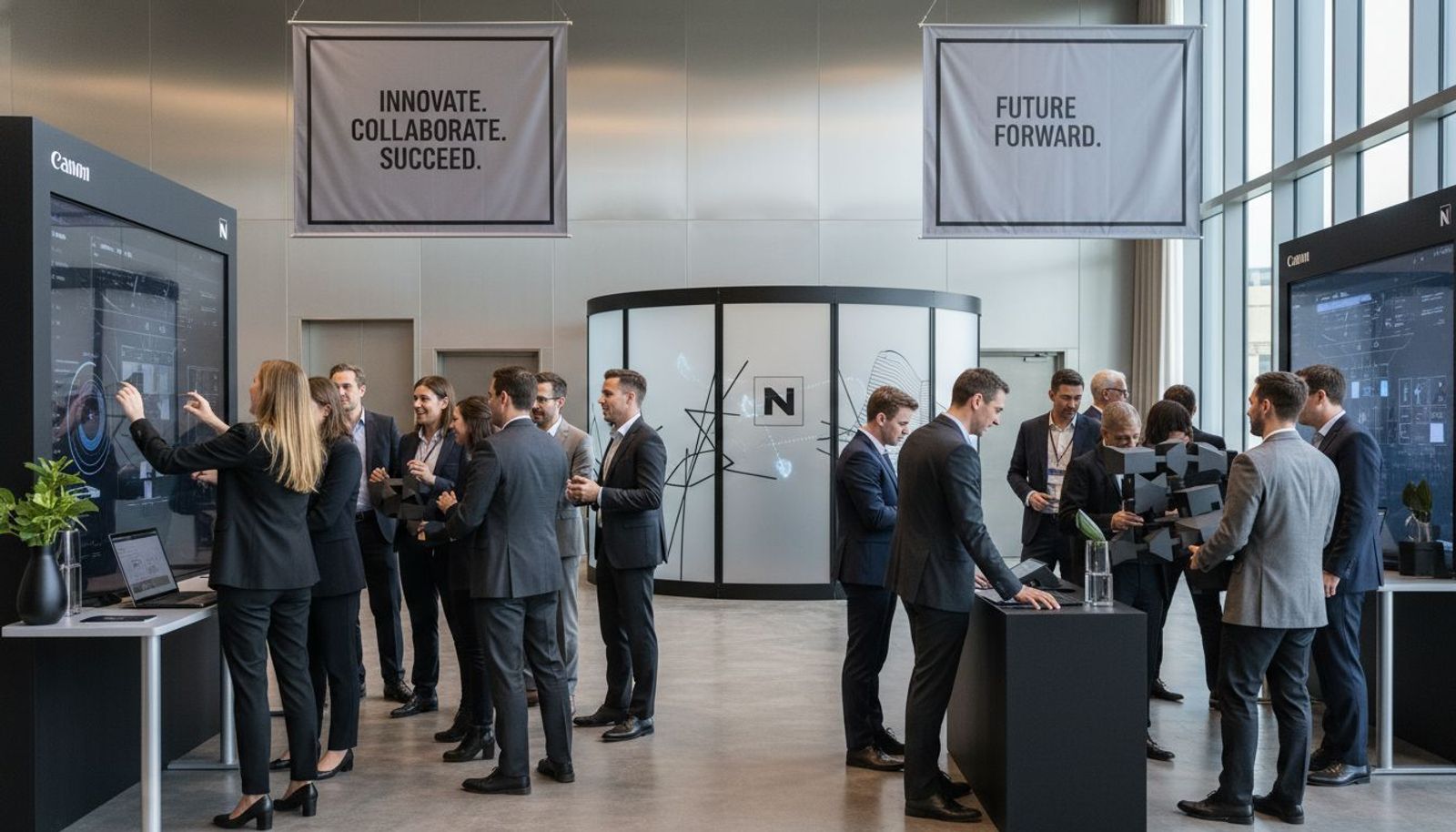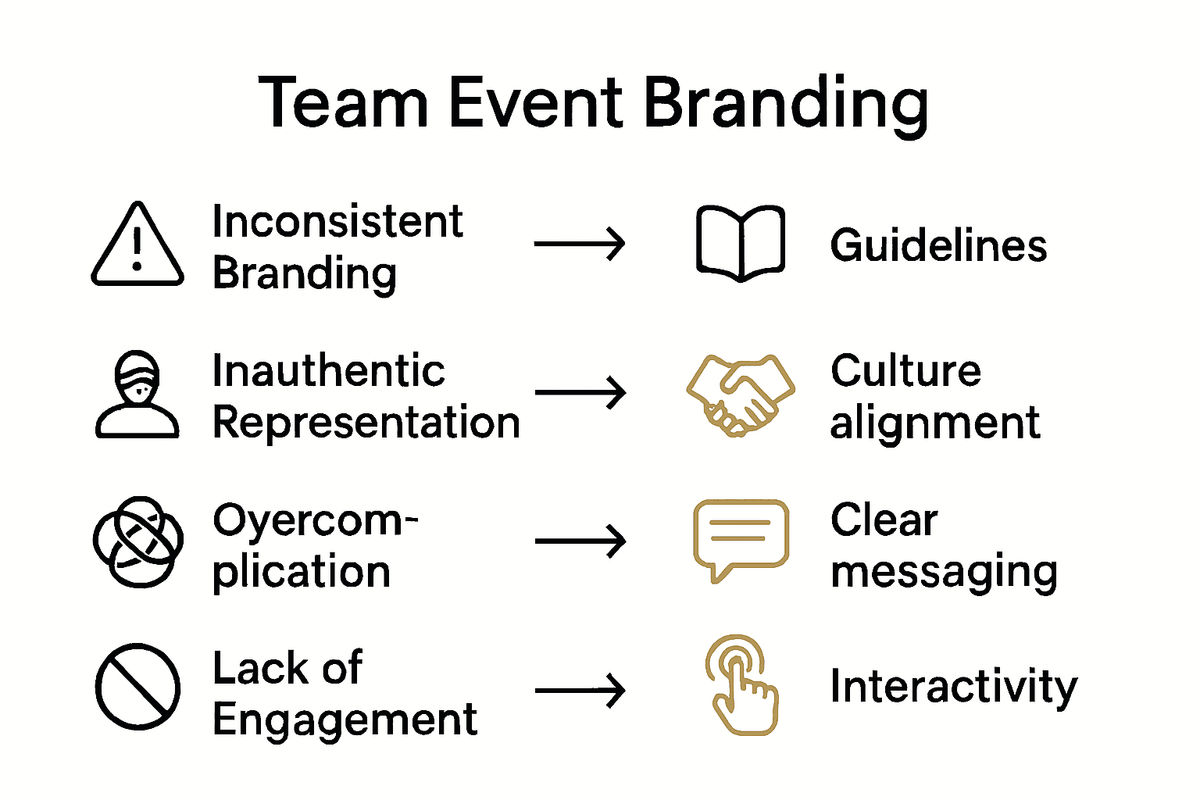Role of Branding in Team Events: Complete Guide
November 3, 2025

Did you know that events with strong branding can increase participant engagement by over 70 percent? Today, connecting teams goes far beyond logos or color schemes. Thoughtful branding transforms ordinary activities into dynamic experiences that leave lasting impressions and help build loyalty. Understanding how branding impacts team events can open the door to more energized collaboration, stronger culture, and memorable group achievements.
Table of Contents
- Defining Branding In Team Event Contexts
- Types Of Branding For Team-Based Activities
- How Branding Enhances Team Engagement
- Implementing Branding Using Digital Platforms
- Risks, Pitfalls, And Best Practices
Key Takeaways
| Point | Details |
|---|---|
| Emotional Connections | Effective branding in team events fosters emotional engagement, transforming attendees into active advocates for the brand. |
| Multi-Sensory Experiences | Brands should create immersive experiences that communicate core values and mission, enhancing deeper emotional ties with participants. |
| Consistent Strategies | Implementing a consistent visual identity and interactive branding fosters genuine connection and reinforces organizational culture. |
| Proactive Management | Organizations must adopt a strategic approach to avoid risks such as inconsistent messaging and inauthentic representation in branding. |
Defining Branding in Team Event Contexts
Branding in team events transcends traditional logo placement and visual aesthetics. According to ijbmer, it represents a strategic narrative designed to create powerful emotional connections that transform participants from passive attendees into active brand advocates.
At its core, event branding is about crafting immersive experiences that communicate an organization's core values, personality, and mission. As research from epub highlights, the event becomes a dynamic platform where brand messages are converted into multi-sensory, lived experiences that generate deeper emotional attachments.
Effective team event branding typically involves several key strategies:
- Consistent visual identity across event materials
- Storytelling elements that reflect organizational culture
- Interactive experiences that reinforce brand messaging
- Strategic use of color, design, and thematic elements
- Opportunities for meaningful participant engagement
By integrating branding thoughtfully, organizations can transform routine team events into powerful communication platforms that not only entertain but also strengthen internal cultural bonds and external brand perceptions. Understanding the Role of Branding in Team Building provides additional insights into this nuanced approach.
Types of Branding for Team-Based Activities
According to bluestone98, there are multiple branding strategies that can be strategically applied to team-based activities, each offering unique opportunities for organizational expression and engagement. These strategies range from brand identity to more specialized approaches that can transform team events into powerful communication platforms.
In team event contexts, different branding types serve distinct purposes. Product branding might involve showcasing organizational merchandise, while service branding could highlight the team's unique capabilities. Personal branding becomes particularly relevant when highlighting individual team member strengths, and digital branding offers innovative ways to extend event experiences beyond physical boundaries.
Specialized branding approaches for team activities can include:
Here's a summary of common branding types for team-based activities:
| Branding Type | Key Features | Example Applications |
|---|---|---|
| Visual Identity | Consistent colors Logos Design elements | Event banners Uniforms Signage |
| Cultural Branding | Values-driven messaging Mission alignment | Team rituals Celebratory ceremonies |
| Performance Branding | Recognition of achievements Skill showcases | Awards Milestone announcements |
| Narrative Branding | Storytelling Personal testimonials | Brand journeys Team member highlights |
| Interactive Branding | Participatory activities Engagement tools | Gamified challenges Workshops |
- Visual Identity Branding: Consistent color schemes and design elements
- Cultural Branding: Reflecting organizational values and mission
- Performance Branding: Highlighting team achievements and capabilities
- Narrative Branding: Creating storytelling elements that resonate with participants
- Interactive Branding: Designing experiences that actively involve team members
For organizations seeking unique ways to implement branding, Understanding the Role of Visual Branding in Business offers comprehensive insights into developing compelling brand strategies that go beyond traditional approaches. When executed thoughtfully, these branding types can transform team activities from routine gatherings into meaningful, memorable experiences that reinforce organizational identity and cohesion.
How Branding Enhances Team Engagement
According to trainingcoursematerial, interactive branding activities offer a powerful mechanism for exploring emotional connections and fostering deeper team engagement. These activities go beyond traditional team-building exercises by creating meaningful experiences that align individual team members with organizational values and narrative.
Team engagement through branding is a multifaceted approach that transforms passive participation into active organizational commitment. Flourishingcreative emphasizes that strategic team-building activities can significantly improve communication, collaboration, and overall team morale when thoughtfully designed around brand principles.
Key strategies for enhancing team engagement through branding include:
- Creating narrative-driven team experiences
- Developing interactive workshops that explore brand identity
- Designing challenges that highlight organizational values
- Implementing collaborative brand storytelling sessions
- Encouraging personal connection with company mission
These approaches move beyond superficial team interactions, transforming branding into a dynamic tool for building genuine organizational connection.
 For managers seeking innovative engagement techniques, 7 Effective Employee Engagement Ideas for Managers provides additional insights into creating meaningful workplace experiences that resonate with team members and reinforce organizational culture.
For managers seeking innovative engagement techniques, 7 Effective Employee Engagement Ideas for Managers provides additional insights into creating meaningful workplace experiences that resonate with team members and reinforce organizational culture.
Implementing Branding Using Digital Platforms
According to Canva, developing a comprehensive marketing content plan is crucial for reinforcing brand associations across digital platforms. Modern organizations can leverage multiple digital channels to create consistent, engaging brand experiences that resonate with team members and external stakeholders alike.
Digital platforms offer unprecedented opportunities for dynamic brand communication. The key is creating a strategic approach that integrates visual storytelling, interactive content, and cohesive messaging across various online touchpoints. This might include social media campaigns, interactive webinars, branded digital event platforms, and collaborative online workspaces that reflect the organization's core identity and values.
Effective digital branding strategies encompass multiple elements:
- Creating consistent visual identity across digital platforms
- Developing platform-specific content strategies
- Utilizing interactive multimedia elements
- Designing responsive and engaging digital experiences
- Implementing real-time brand communication tools
For managers looking to enhance their digital branding approach, Understanding the Purpose of Customizable Branding provides additional insights into creating flexible, impactful digital brand experiences that can adapt to evolving organizational needs and technological landscapes.
Risks, Pitfalls, and Best Practices
According to ijbmer, continual innovation and a personalized approach are critical for organizations seeking to build strong, resilient branding strategies. The landscape of team event branding is fraught with potential challenges that can undermine even the most well-intentioned efforts, making a proactive and strategic approach essential.
The most significant risks in team event branding often stem from inconsistent messaging, lack of authentic representation, and failure to align brand experiences with organizational values. epub emphasizes that brand experiences must be transformative, creating multi-sensory connections that generate genuine emotional attachment beyond superficial marketing tactics.
Key risks and corresponding best practices include:
-
Inconsistent Branding
- Risk: Fragmented messaging across different platforms
- Best Practice: Develop comprehensive brand guidelines
-
Inauthentic Representation
- Risk: Creating experiences that feel forced or artificial
- Best Practice: Align events with genuine organizational culture
-
Overcomplication
- Risk: Making branding too complex or abstract
- Best Practice: Keep messaging clear and relatable
-
Lack of Engagement
- Risk: Passive, one-way communication
- Best Practice: Design interactive, participatory experiences
For managers seeking to navigate these challenges effectively, Understanding the Role of Custom Branding in Business offers additional strategic insights into creating meaningful, impactful brand experiences that resonate with team members and stakeholders.
Elevate Your Team Events with Customized Branding and Engaging Experiences
The article highlights the challenge teams face in creating authentic emotional connections through powerful, interactive branding during events. Common pain points include inconsistent messaging, lack of genuine participant engagement, and difficulty aligning activities with core organizational values. Concepts like narrative branding and interactive experiences play a crucial role in transforming attendees into enthusiastic brand advocates.
At Quizado, we understand these challenges and offer a flexible platform designed to bring your brand to life through customizable quiz games. With features such as personalized logos, themed interfaces, and team-based configurations, you can create immersive team-building experiences that reinforce your company’s culture and values. Whether online or offline, our platform lets you engage team members actively while strengthening brand identity in a fun and memorable way.
Looking to make your next team event truly impactful? Discover how easy it is to weave branding into interactive game experiences at Quizado.

Bring your brand story to life with custom team quizzes that foster collaboration and excitement. Visit Quizado now to start creating engaging team-building games that resonate with your company’s mission and culture. Explore insights at Understanding the Role of Branding in Team Building and maximize your team engagement with proven strategies from 7 Effective Employee Engagement Ideas for Managers. Act today to transform ordinary events into powerful brand experiences.
Frequently Asked Questions
What is the role of branding in team events?
Branding in team events focuses on creating emotional connections through immersive experiences that reflect an organization's core values and mission, transforming attendees into advocates.
How can branding enhance team engagement during events?
Branding enhances team engagement by transforming passive participation into active commitment through narrative-driven experiences, interactive workshops, and collaborative activities that align with organizational values.
What are the different types of branding strategies for team-based activities?
Key branding strategies include visual identity branding (consistent design elements), cultural branding (values-driven messaging), performance branding (recognizing achievements), narrative branding (storytelling), and interactive branding (engaging experiences).
What risks should organizations consider when implementing branding at team events?
Organizations should be aware of risks like inconsistent messaging, inauthentic representation, overcomplicated branding, and lack of engagement. Best practices to mitigate these risks involve developing clear guidelines and designing participatory experiences.





